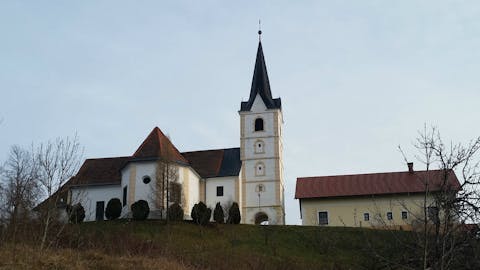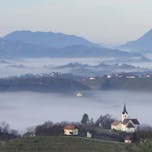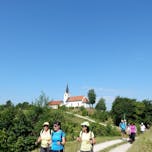
Cirkulane Municipality
Church of St. Ana
The Pilgrimage Church of St. Ana in Veliki Vrh stands on the top of a high hill, also known as Strabolšak. It was built in the 17th century, during a period of intense construction activity in the parish of St. Barbara. At that time, the churches of St. Catherine and St. Barbara were remodeled in the Baroque style, the castle chapel of the Holy Trinity at Borl was built, along with the subsidiary churches of St. Elizabeth and St. Urban.
The Church of St. Ana was commissioned by the Borl nobleman, Count Franc Anton Sauer, between 1695 and 1699, when it was consecrated. According to some sources, the church was built as a vow by the count and his wife, Marija Ana, who had to wait 12 years for the birth of their only son, Franc Jožef.
The church was later renovated several times. In 1865, the parish priest ordered a new roof structure and the restoration of the altars. In 1922, the bell tower was repaired and heightened after being damaged by a violent storm in 1915.
In the 18th century, a Way of the Cross was constructed leading to the church, of which only one chapel remains today. In 1908, a new rectory and a pilgrims’ house were also built near the church.



In 1916, all three bells were taken from the church, and in 1943 another bell was removed—the same one that parish priest Janez Vogrin had commissioned for the church in 1920.
The church is adorned with high-quality Baroque furnishings from the late 17th and early 18th centuries. The high altar and the two side altars are the work of the Maribor sculptor Franc Krištof Reiss, dating from the late 17th century. The high altar was once decorated with a precious painting of St. Ana by the renowned Styrian painter Janez Vid Hauckh, created in 1699, but unfortunately the painting was stolen some years ago.
Today, the church also houses the altar of St. Urban, the patron saint of vineyards, which was transferred from the Church of St. Urban at Vrbajnščak. That church was struck by lightning and burned down in the early 19th century, and it was never rebuilt.
In recent years, both the church interior and the pilgrims’ house have been restored, and the surroundings have been carefully arranged. Pilgrims can reach the church by two routes: the first is a footpath leading from Dolane through the forest, following the Stations of the Cross to the top; the second is an asphalt road branching off near the factory in Dolane, winding among the vineyards to the hilltop.
Text: Mira Jerenec
Source: The Book “Svet Belanov”, Cirkulane, 2005